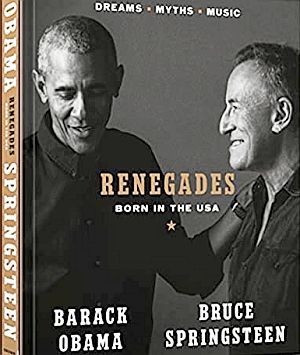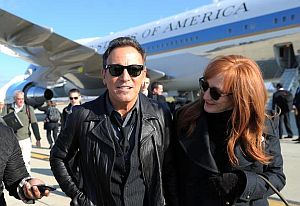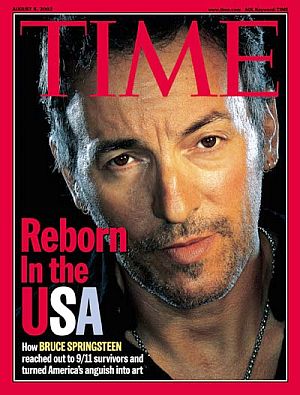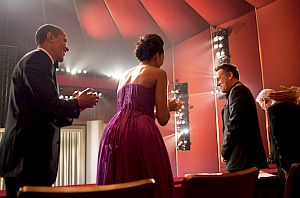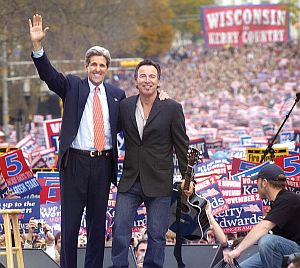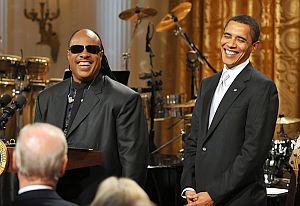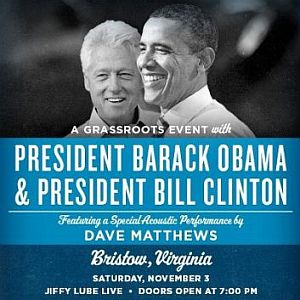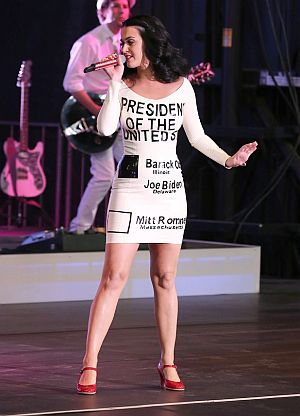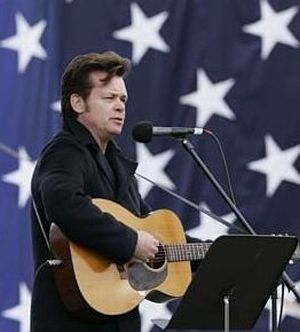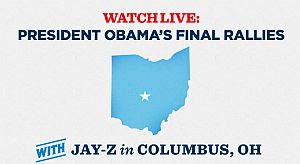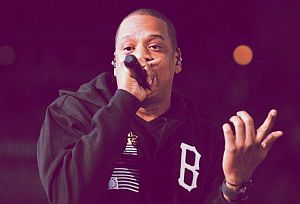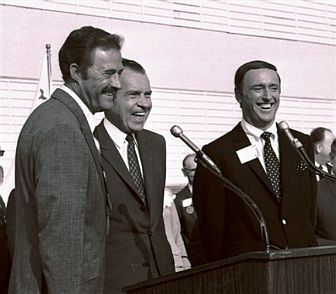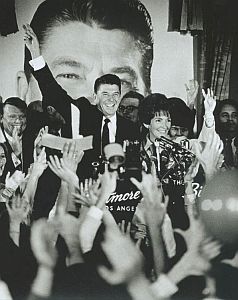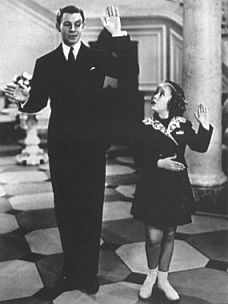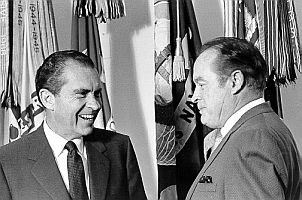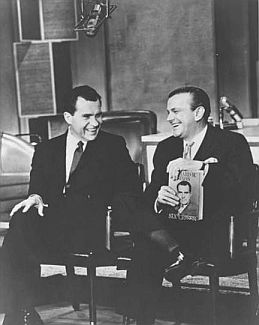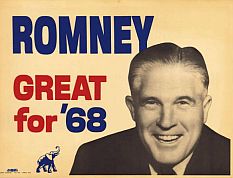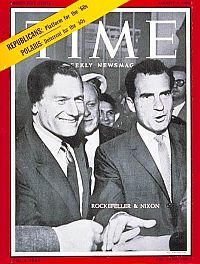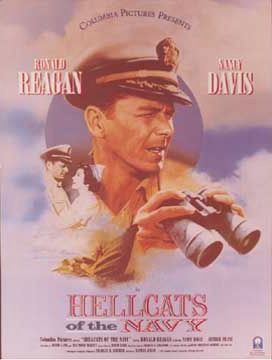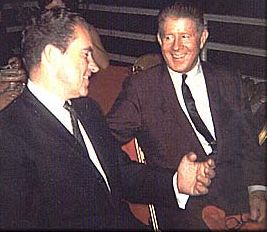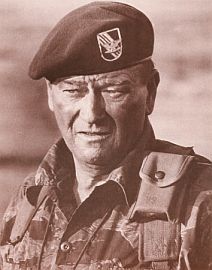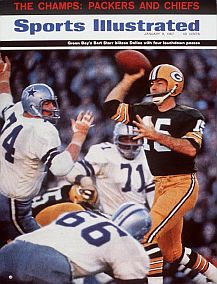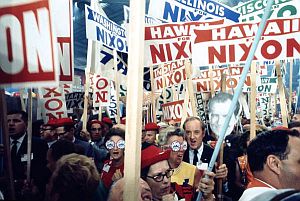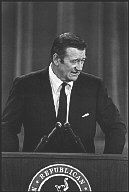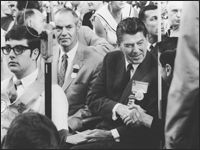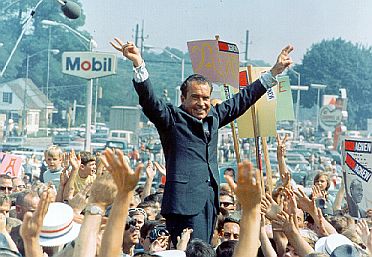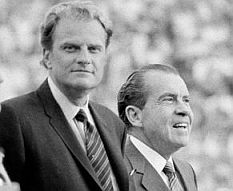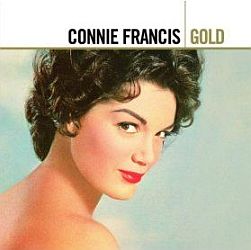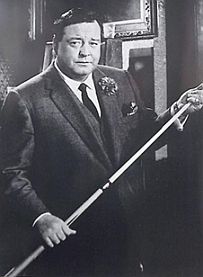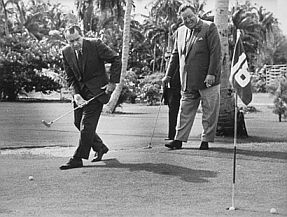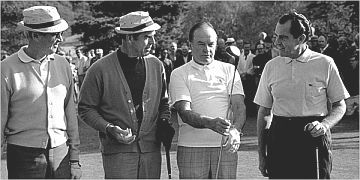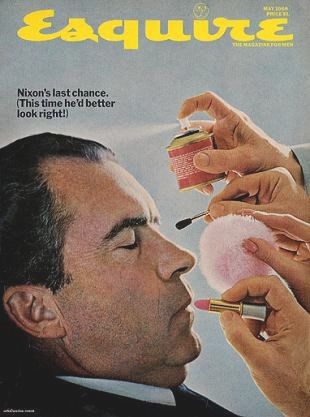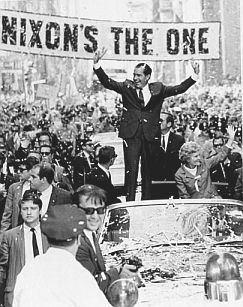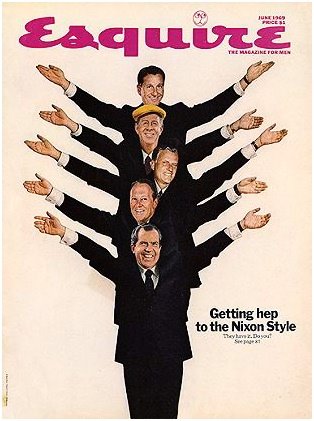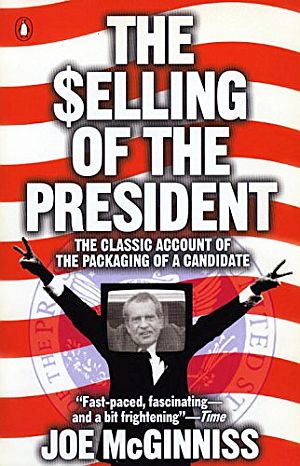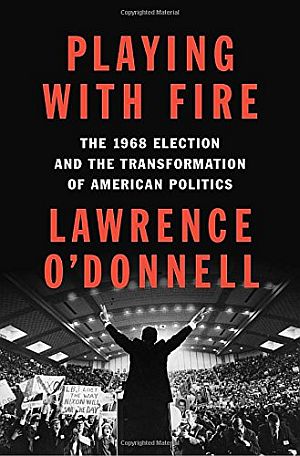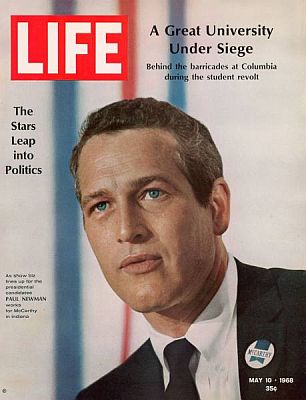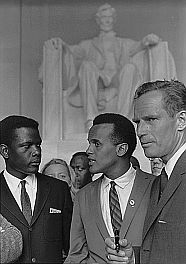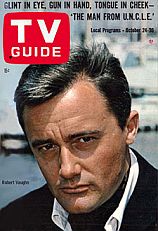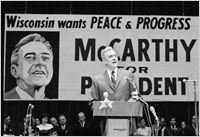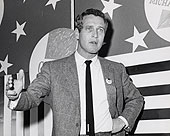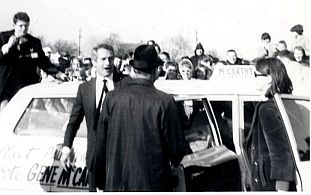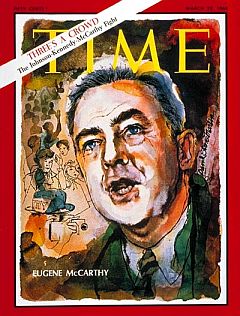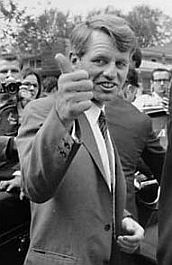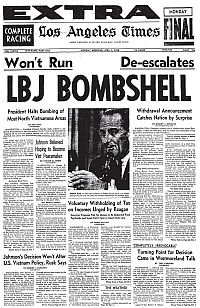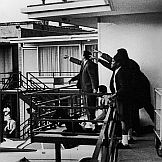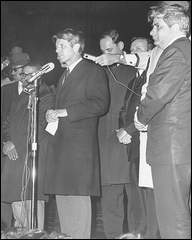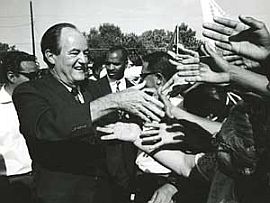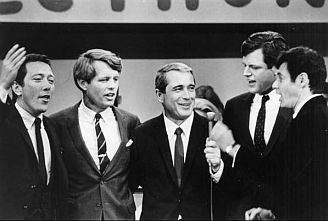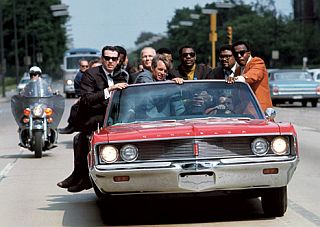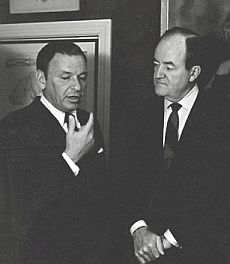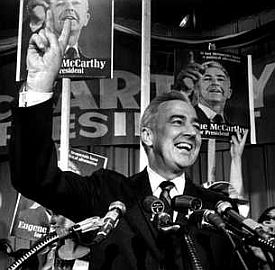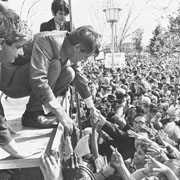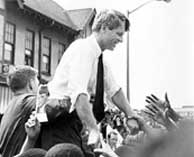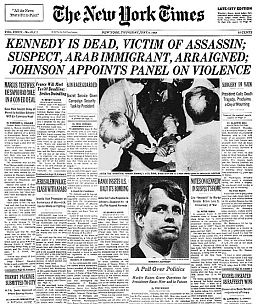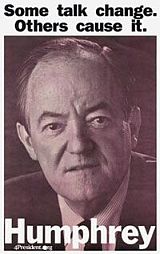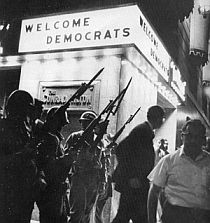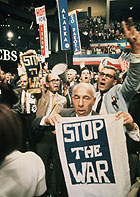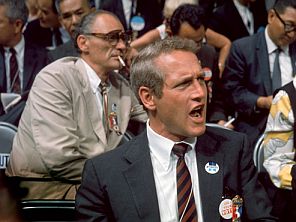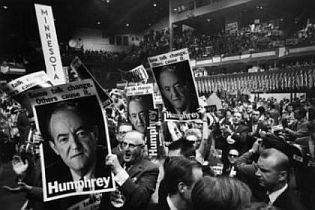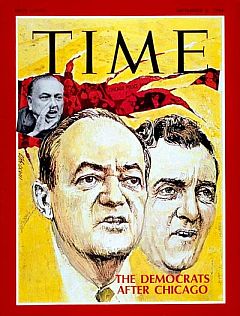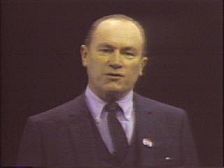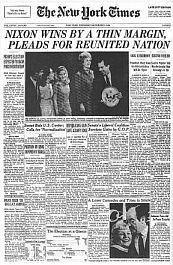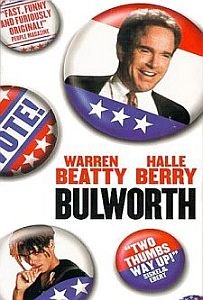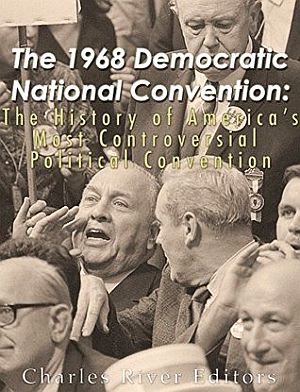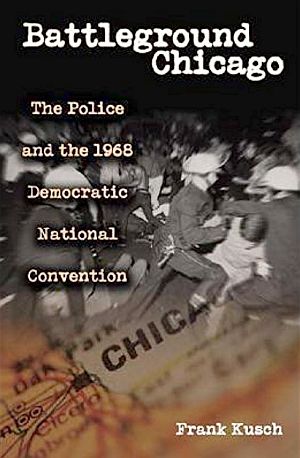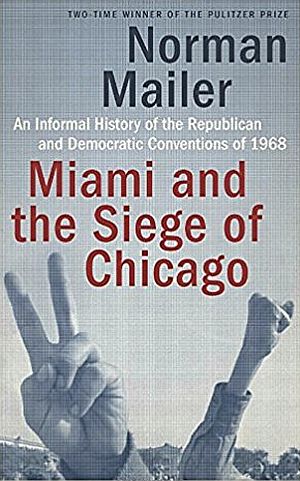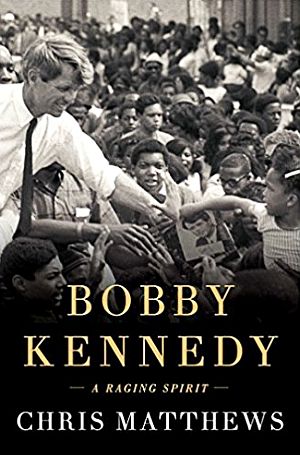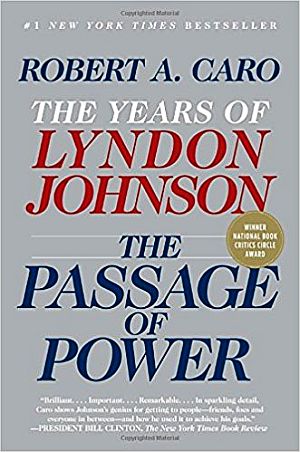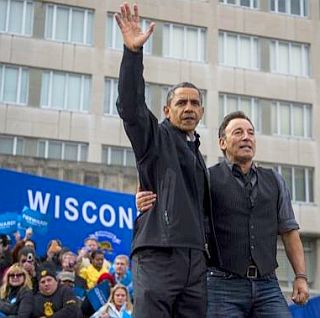
President Barack Obama and rock star Bruce Springsteen stand arm-in-arm at Madison, Wisconsin campaign rally on November 5, 2012. Photo, Nikki Kahn/Washington Post.
On election day November 6th, The Washington Post ran a front page photo from that event of the President standing arm-in-arm with rock legend Bruce Springsteen as he waved to the crowd.
Other newspapers and news wires also used this photograph or similar ones of the same Obama-Springsteen appearance.
The photo captures a political moment, certainly, but it also underscores how important celebrity endorsements and celebrity imagery have become in elections of all kinds – even though political analysts have said time and time again, that celebrities have only a marginal effect on persuading voters to go with one candidate or another.
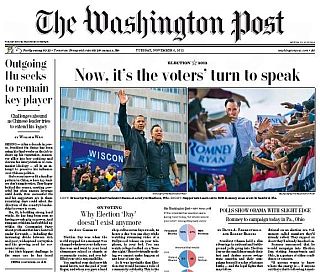
Front page of November 6th, 2012 edition of Washington Post newspaper using the Obama-Springsteen photo.
There may also be something of a first in the Washington Post putting this image on its front page. How many times has a sitting president appeared in a campaign photo arm-and-arm with a celebrity that ran on the front page of a national newspaper – or on the cover of a major news magazine? Presumably, that’s pretty rare – especially on election day.
But perhaps that’s a moot question in these times since presidents and presidential candidates appear frequently with celebrities in many public venues.
And yes, politicians have been courting the rich, famous, and otherwise influential since forever. Politicians in ancient Rome no doubt sought out famous gladiators and popular generals to do their bidding.
More recently, in 20th century American politics, Franklin D. Roosevelt sought Frank Sinatra’s help in the 1940s – as did John F. Kennedy in 1960. On television, Richard Nixon appeared on Jack Parr’s late night TV talk show in 1963, and also in one memorable 1968 Laugh-In TV spot.
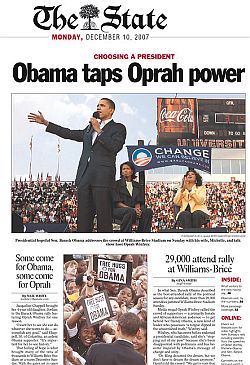
The December 2007 endorsement of U.S. Senator Barack Obama for president by TV celebrity Oprah Winfrey (yellow jacket) made front page news across the country.
Today of course, politicians appear regularly on TV shows such as the Late Show with David Letterman, The Tonight Show with Jay Leno, The View, The Daily Show with Jon Stewart, and others. And with the web and You Tube, images of politicians and celebrities are now quite ubiquitous. It is also noted that in recent years even papers like the Washington Post have included more coverage of celebrities in politics, with regular sections devoted to celebrity doings on all manner of public policy, consequential or not.
Yet there is still something indelible and lasting about photographs of the Springsteen-Obama variety displayed on the front pages of major newspapers. Clearly, the decisions by major news organizations to use such images in prominent display are not minor matters, or made without purpose. In this specific case, no doubt, the choice of photo and its placement likely had something to do with the type of Midwest working-class voters that pundits were saying Obama absolutely needed to win re-election – and Bruce Springsteen’s appeal to those very same voters. But beyond these questions of news organization photo choices and the play now given celebrities in politics, the Obama-Springsteen alliance is interesting in its own right, and has a history that now stretches over several years. Some of that history follows below.
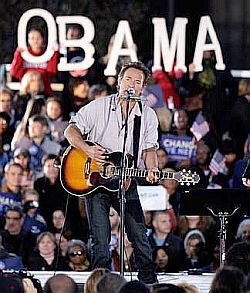
Bruce Springsteen performing at an Obama campaign rally in Cleveland, Ohio, 2008.
Bruce Springsteen had been in Barack Obama’s corner since at least April 2008 when he first endorsed then U.S. Senator Barack Obama for the Democratic presidential nomination. Obama at the time was battling Hillary Clinton for his party’s presidential nomination. Springsteen, who first became a rock sensation in the mid-1970s, has been sought out by politicians for years who have tried to associate with his music, gain his endorsement, and/or use his name in a speech, as Ronald Reagan did when he was campaigning for reelection in New Jersey in September 1984.
But in April 2008 when Springsteen endorsed Obama, the rock star explained that the candidate “speaks to the America I’ve envisioned in my music for the past 35 years.” In a letter Springsteen posted on his website addressed to friends and fans, he explained that he believed Obama was the best candidate to undo “the terrible damage done over the past eight years.” In Springsteen’s view, Obama had “the depth, the reflectiveness, and the resilience to be our next president…”
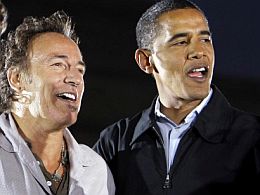
Nov. 2, 2008: Bruce Springsteen with then presidential candidate Sen. Barack Obama at rally in Cleveland, Ohio. AP photo/Alex Brandon.
At one Ohio rally during the 2008 campaign, Springsteen discussed the importance of “truth, transparency and integrity in government, the right of every American to have a job, a living wage, to be educated in a decent school, and a life filled with the dignity of work, the promise and the sanctity of home…But today those freedoms have been damaged and curtailed by eight years of a thoughtless, reckless and morally-adrift administration.”
On the night of Obama’s electoral victory, November 4, 2008, Springsteen’s song “The Rising” was the first song played at the Chicago Grant Park rally after Obama’s victory speech.
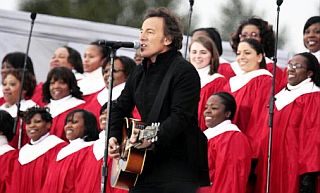 Bruce Springsteen performing "The Rising" with an all-female choir at President Obama’s inauguration, 2009. |
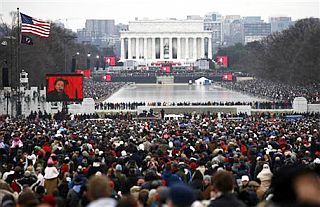 January 18, 2009: Scene around the Lincoln Memorial in Washington, D.C. during inaugural concert & festivities. |
Bruce Springsteen was also the opening musical act for the Obama Inaugural Celebration at the Lincoln Memorial in Washington, D.C. on January 18, 2009 – an event attended by more than 400,000 people.
At that celebration, Springsteen performed “The Rising” with an all-female choir and also sang Woody Guthrie’s “This Land Is Your Land” with Pete Seeger. Springsteen and Seeger were not the only performers that day, as a number of others performed then and through the evening with the various inaugural balls.
A long list of Hollywood stars and musical artists came to Washington as invited performers, readers, and special guests to fete Obama on his special day. A partial list of some of those involved in the inaugural festivities include the following: Jack Black, Mary J. Blige, Jon Bon Jovi, Garth Brooks, Steve Carrell, Sheryl Crow, Rosario Dawson, Renee Fleming, Jamie Foxx, Josh Groban, Herbie Hancock, Tom Hanks, Heather Headley, Ashley Judd, Martin Luther King III, Beyonce Knowles, Queen Latifah, Bettye Lavette, John Legend, Laura Linney, George Lopez, Jennifer Nettles, John Mellencamp, Kal Penn, Shakira, James Taylor, Marisa Tomei, Usher, U2, Denzel Washington, Forest Whitaker, will.i.am, Stevie Wonder, Tiger Woods, and others.
Kennedy Center Honors
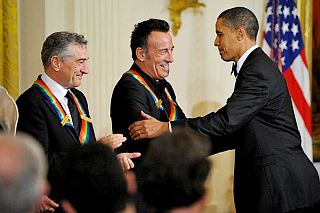
Actor Robert De Niro looks on as President Obama congratulates Bruce Springsteen as a Kennedy Center Honoree during a December 2009 White House ceremony.
…Finally, we honor the quiet kid from Jersey — (laughter) — who grew up to become the rock ‘n’ roll laureate of a generation. For in the life of our country only a handful of people have tapped the full power of music to tell the real American story — with honesty; from the heart; and one of those people is Bruce Springsteen.
He has said: “I’ve always believed that people listen to your music not to find out about you, but to find out about themselves.” And for more than three decades, in his songs — of dreams and despair, of struggle and hope — hardworking folks have seen themselves.
They’ve seen their great state of New Jersey. And they’ve seen their America — in songs that become anthems. Restless kids who were “Born to Run.” The struggles of workers in “My Hometown.” The sacrifices of vets who were “Born in the U.S.A.” Love and loss in “Streets of Philadelphia.” A resilient nation in “The Rising.” And, this year, a country “Working on a Dream.”
…[W]hen I watched him on the steps of the Lincoln Memorial when he rocked the National Mall before my inauguration,I thought it captured as well as anything the spirit of what America should be about…
– President Barack Obama
It’s no wonder that his tours are not so much concerts, but communions. There’s a place for everybody -— the sense that no matter who you are or what you do, everyone deserves their shot at the American Dream; everybody deserves a little bit of dignity; everybody deserves to be heard.
I’ve seen it myself. Bruce was a great fan — a great friend over the last year, and when I watched him on the steps of the Lincoln Memorial when he rocked the National Mall before my inauguration, I thought it captured as well as anything the spirit of what America should be about. On a day like that, and today, I remember: I’m the President, but he’s The Boss. (Applause.)
And Bruce continues to inspire, along with his “house-rocking, earth-shaking” E Street Band. At 60 years old, he’s still filling stadiums, still whipping fans into a frenzy, still surfing the crowd, still jumping off pianos, and still reaching new fans, and still being nominated for Grammys. It’s been a long road from that stage at Stone Pony in Asbury Park to this stage today, but this much we know — after more than 30 years and 120 million albums sold, Bruce Springsteen is still one “cool rockin’ Daddy.” (Laughter and applause.)
At the Kennedy Center ceremony, Springsteen was also lauded by several celebrities including Jon Stewart, with musical tributes from John Mellencamp, Ben Harper, Jennifer Nettles, Melissa Etheridge, Eddie Vedder, and Sting. Meanwhile, back in Springsteen’s home state of New Jersey, some developments on the Republican side of the political aisle during 2009 would also involve the singer and his music.
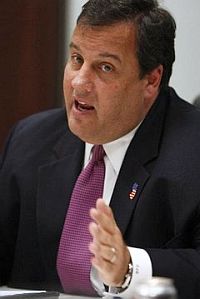
2009: New Jersey’s Chris Christie.
In November 2009, Chris Christie – then an up-and-coming Republican star in New Jersey’s political ranks who had been a top fundraiser for George W. Bush’s 2000 presidential campaign, and later, New Jersey’s U.S. attorney – was elected governor. He had defeated former Democratic governor and U.S. Senator Jon Corzine. Christie was also a devoted Bruce Springsteen fan who had attended more than 120 of Springsteen’s concerts.
Christie regarded Springsteen’s politics as a form of populism that anyone could identify with, though he parts ways with Springsteen on some of his core philosophy, such as his view that “nobody wins unless everybody wins.” Christie holds “that in life there are winners and losers — there just are… We can’t make everybody winners. But you can make more people winners.” Christie says he doesn’t take Sprinsteen’s politics personally. For him, with Springsteen, it’s the music that matters.
After his election, Christie wanted nothing more than to have Springsteen appear at his inauguration, scheduled for January 2010. Through an intermediary, Christie sent word to Springsteen’s manager, Jon Landau, to ask if Springsteen would perform. Christie offered to make a gift to Springsteen’s charity of choice if he would agree to perform for the governor-elect.In late 2009, New Jersey governor Chris Christie wanted Springsteen to perform at his inaugural festivities. Knowing that Springsteen was a Democrat, Christie’s people also offered to put a little distance between the Christie inauguration and any Springsteen event, suggesting a benefit concert in the week leading up to the January 19th inaugural. The editors of The Star Ledger newspaper of Newark, New Jersey, the state’s largest circulation newspaper, even ran an editorial on November 7th urging Springsteen to do the concert, saying the state needed “a Kumbaya moment.” But word came back that Springsteen did not want to get involved in state politics. Springsteen’s rejection was reportedly polite – that he was quite aware that Christie was a fan, and as a loyal citizen of New Jersey, wished him every success as governor. Christie’s people then arranged for the B Street Band, a Springsteen tribute band, to perform at the governor-elect’s inaugural party. But there would be more to come with Christie and Springsteen later. Christie, in any case, became more of a national figure as he began to be touted as a possible Republican Presidential candidate.
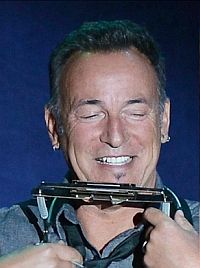
Bruce Springsteen with harmonica.
In early 2012, it appeared that Springsteen was not going to become involved in the Obama re-election campaign. In January, he told ABC News: “I prefer to stay on the sidelines… I genuinely believe an artist [is] supposed to be the canary in the coal mine, and you’re better off with a certain distance from the seat of power.”
Springsteen noted at the time that he wasn’t entirely happy with Obama’s first term. He said he would have liked to have seen “more activism in job creation sooner than it came,” but that Obama had generally done a good job up to that, ticking off some of the President’s accomplishments: “…He kept GM alive, which was incredibly important to Detroit and Michigan, and he got the health care law passed, although I wish there had been a public option and didn’t leave the citizens victims of the insurance companies. He killed Osama bin Laden, which was extremely important. He brought some sanity to the top level of government.”
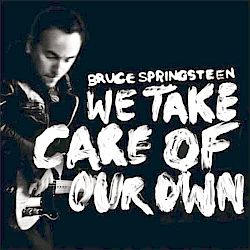
Cover art for Bruce Springsteen single, "We Take Care of Our Own."
Music Player
“We Take Care Of Our Own”
Wrecking Ball wouldn’t be released until March 2012, but one of its songs was released early – “We Take Care of Our Own” – which made its live debut on February 12, 2012 at the 54th Grammy Awards.
The song is a lament that finds a nation in trouble, hinting at the divided partisanship and a government that has had its failings in helping people. “I been looking for the map that leads me home,” Springsteen sings. “I been stumbling on good hearts turned to stone / The road of good intentions has gone dry as a bone.” The song’s central message appears to be that we are a nation that does take care of our own – that is our core philosophy and who we are; something we all understand. Yet we haven’t always done that, and sometimes we falter. And now, in the throes the current hard times, the Springsteen song is reminding us that we need to get back to that task, as he sings:. “Wherever this flag’s flown, we take care of our own.”
On February 9th, 2012, a few days before the song’s airing at the Grammy Awards, Obama’s reelection team released a playlist of five songs the campaign would be using at campaign rallies. Among the songs was Springsteen’s “We Take Care of Our Own.” Others on the list included: “I Got You” by Wilco; “Roll With The Changes” by REO Speedwagon; “You’ve Got The Love” by Florence & The Machine; and, “Let’s Stay Together” by Al Green.
|
“We Take Care of Our Own” I’ve been knockin’ on the door that holds the throne From Chicago to New Orleans Where’s the eyes, the eyes with the will to see We take care of our own |
However, the Springsteen tune became a popular and often used song during the Obama campaign – as its main refrain – “we take care of our own” – was generally a good fit with what the Obama Administration was trying to do with its economic recovery programs; trying to lift the nation out of its hard times. At the Democratic National Convention in early September 2012, the song also received some prime-time exposure when it was played immediately following Barack Obama’s speech on September 6th. While Obama’s speech may not have been the highlight of the convention, the airing of the Springsteen song at that time helped boost the music. According to Billboard, sales for “We Take Care Of Our Own” jumped more 400 percent during the weekend that ended September 9, 2012, following Obama’s speech. And by late September, after Mitt Romney’s remarks at a private fundraiser were made public about how “47 percent” of the electorate were victims and that he wouldn’t have to worry about them if elected President, the Springsteen song, “We Take Care of Our Own,” took on even more resonance at the Obama rallies.
But Springsteen himself had repeated his intent to stay out of the race, making remarks to The New Yorker in July 2012, saying that he wasn’t sure whether he’d get involved again: “I did it twice [once for Kerry in 2004 and Obama in 2008] because things were so dire… It seemed like if I was ever going to spend whatever small political capital I had, that was the moment to do so. But that capital diminishes the more often you do it. While I’m not saying never, and I still like to support the President, you know, it’s something I didn’t do for a long time, and I don’t have plans to be out there every time.” But as the race tightened in late September and early October, especially following Obama’s faltering in the first debate, Springsteen once again became a more visible Obama supporter.
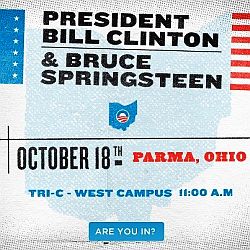 Ticket to Bill Clinton-Bruce Sprinsteen rally for Obama in Parma, Ohio. |
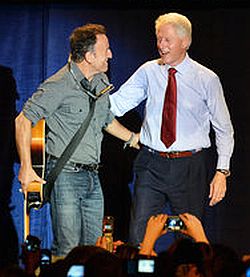 Bill Clinton greeting Bruce Springsteen on stage at Parma, Ohio Obama rally. |
By October 13th, the White House was reporting that Springsteen would campaign for Obama. “Bruce Springsteen’s values echo what the President and Vice President stand for: hard work, fairness, integrity,” said Jim Messina, Obama for America’s campaign manager. “His appearances will help with our get out the vote effort in these critical swing states and we are thrilled with his ongoing support.”
On October 17, 2012, Springsteen took to his website to explain his support for the President. “A message from Bruce” noted in part: “Right now, there is a fight going on to help make this a fairer and more equitable nation. For me, President Obama is our best choice to get us and keep us moving in the right direction…” In the message, Springsteen also voiced support for “sterling candidates” Sen. Sherrod Brown (D-Ohio) and Elizabeth Warren, the Massachusetts Democrat seeking a U.S. Senate seat.
On the following day, October 18th, 2012, Springsteen joined former president Bill Clinton at an Obama campaign rally in Parma, Ohio, near Cleveland. A crowd of 3,000 fill a gymnasium at Cuyahoga Community College, with 700 more in an overflow area.
Rosalind Helderman of the Washington Post filed her story on the event with the opening: “President Obama brought the big guns — Bubba and the Boss — to Ohio Thursday to shore up his slim edge in the key battleground state.” Bill Clinton, for his part, said during the rally, as reported by the New York Times: “This is the first time in my life I ever got to be the warm-up act for Bruce Springsteen… I am qualified ’cause I was born in the U.S.A.,” said Clinton, “and unlike one of the candidates for president, I keep all my money here!”
Springsteen told the Ohio crowd that he’d spent three decades “writing about the distance between the American dream and the American reality” and believed Obama was the man to help close the gap between the two. Voting, he said, was “the principle way we get to determine that distance and that equation… Voting matters. Elections matter.”

Bruce Springsteen performing with acoustic guitar at Obama rally in Parma, Ohio.
On Saturday afternoon, October 27th in Pittsburgh, for example, he performed for Obama before a capacity crowd at the Soldiers and Sailors Memorial Hall and Military Museum.
In late October, however, as Hurricane Sandy began its destructive trek up the East Coast, the presidential campaign was temporarily overshadowed. But this event, too, figured into the Obama-Springsteen interplay and national politics.
Hurricane Sandy
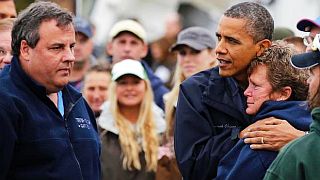
President Barack Obama hugs marina owner Donna Vanzant as he tours hurricane-damaged Brigantine, N.J., with Gov. Chris Christie, Oct. 31, 2012. Photo, Larry Downing /Reuters.
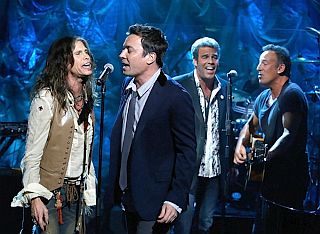
Steven Tyler, Jimmy Fallon, Mark Rivera & Bruce Springsteen perform during NBC's Hurricane Sandy telethon which raised 32 million dollars. Photo, Heidi Gutman/NBC
On Friday November 2nd, 2012, Springsteen and Jon Bon Jovi, also a New Jersey native, joined Sting, Christina Aguilera and other music stars for an NBC-organized televised benefit concert to raise funds for victims of Sandy. The show, titled “Hurricane Sandy: Coming Together” was organized by NBC as a commercial-free one- hour benefit. In addition to Bon Jovi, Sting, Springsteen and Agulera were other performers and celebrities, including: Billy Joel, Jimmy Fallon, Steven Tyler, Mary J. Blige, Tina Fey, Jon Stewart, Whoopi Goldberg, Danny DeVito and NBC News’ Brian Williams. Today show co-anchor Matt Lauer was the host. During the show, Springsteen joined Billy Joel, Steven Tyler and Jimmy Fallon for a performance of “Under the Boardwalk.” Springsteen and the E Street Band closed the show on a message of hope with a rousing rendition of their tune “Land of Hope and Dreams.” The telethon raised some $32 million. All money was donated to the American Red Cross.
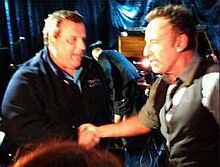
Gov. Christie & Bruce Springsteen back- stage at NBC's Hurricane Sandy telethon.
A few days later, when Springsteen was traveling with Obama to make a few final campaign stops, the President was getting a post-Sandy telephone update from Christie when he told the governor he had someone who wanted to talk with him, bringing Springsteen on the line. “We had a good conversation today,” said Christie of the call. “It was great to talk to the president and even better to talk to Bruce.”
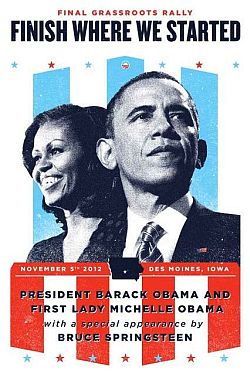
Poster for final campaign event in Des Moines, Iowa for Nov 5, 2012 with the President, Michelle Obama & Bruce Springsteen.
Campaign Resumes
As the presidential race resumed in early November, the Obama campaign announced that Springsteen would be making more appearances at Obama rallies in Wisconsin, Ohio, and Iowa on November 5th, 2012, the day before the election. Springsteen then appeared on that day at three rallies for Obama – one in Madison, Wisconsin; one in Columbus, Ohio with Jay-Z; and a final appearance in Des Moines, Iowa with the president and Michelle Obama.
Other entertainers would also appear for Obama the final weekend before the election – John Mellencamp, Saturday, November 3rd in Iowa; Dave Matthews the same day in Virginia; and Stevie Wonder on Sunday November 4th in Cincinnati. Springsteen and his wife Patti, meanwhile, would travel with Obama on Air Force One for at least part of the tour on November 5th. Reportedly, the President even remarked: “I’m going to be flying with Bruce Springsteen on the last day I’ll ever campaign, that’s not a bad way to bring it home.”
On that day, November 5th, the first of three stops was Madison, Wisconsin, the state capital, and home to the University of Wisconsin. The rally took place in the streets near the capitol building. Some 18,000 supporters had gathered there in the cold as early as 6:30 a.m., four hours before Obama would arrive.
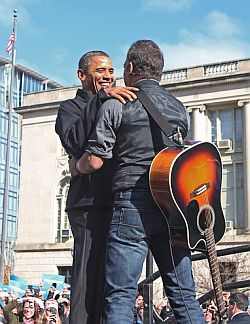
President Barack Obama greeting Bruce Springsteen at Madison, WI campaign rally.
On the way to the next rally, in Columbus, Ohio, Springsteen sat with Obama aboard Air Force One as the two discussed the Hurricane Sandy recovery effort then underway in New Jersey. That’s when the President was also speaking on the phone with Governor Chris Christie, and when he brought Springsteen on the line to chat briefly with the governor.
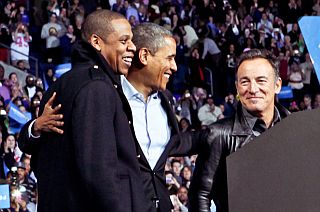
President Barack Obama on stage at Columbus, Ohio rally Nov. 5, 2012, flanked by Jay-Z and Bruce Springsteen.
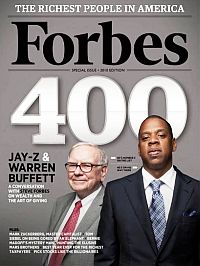
Jay-Z on the cover of the Forbes 400 "rich list" issue for 2010, along with Warren Buffett.
During the Columbus rally, Obama remarked of some similarities between he and Jay-Z:
“Nobody would expect us to be where we are today if they had met us as younger men, both of us have daughters, and both of us have wives who are more popular than we are.”
Obama also told the crowd that Jay-Z and Springsteen were examples of “what our country is about” – two guys who rose from humble beginnings to go on to fame and fortune.
Their music that day, in any case, helped bring out a diverse and appreciative crowd. Karmesha Hicks, a 20-year-old student from Berea, Ohio attending the rally told a reporter on the way out : “It was very inspirational… I love that he brought two very different artists together. It shows what he [Obama] is about.”
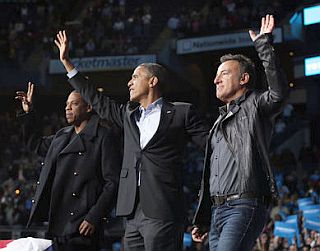
Jay-Z, President Obama & Bruce Sprinsteen have one last wave to the crowd in Columbus, Ohio.
Ohio: 29th Time
For Obama, the Columbus rally marked his 29th political appearance in Ohio for 2012. The president had also done a number of taped radio interviews that day, dropped in for a visit at his Columbus campaign office, and appeared on ESPN during halftime of “Monday Night Football” that evening, as did Mitt Romney.
A few hours later that same day, also in Columbus, Romney and his wife Ann appeared before an enthusiastic crowd in a large airport hangar at Port Columbus. At that rally, the Marshall Tucker Band helped stir the crowd for Romney and he also had two well-known Ohio athletes speak there before he took the podium – ice skater Scott Hamilton and pro golfer Jack Nicklaus.
Back at the Obama rally at the Nationwide Arena, President Obama, after he gave his speech, brought Springsteen and Jay-Z back up to the stage (along with the prior speakers as well) for one last wave to crowd — this as a recorded version of “We Take Care of Our Own” played in the background. Then it was on to Iowa.
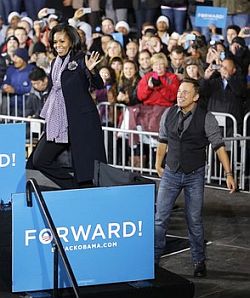
Bruce Springsteen escorted first lady Michelle Obama to the stage in Des Moines, 5 Nov `12.
Des Moines
According to a New York Times report, Air Force One arrived at the Des Moines airport at 8:59 p.m. Central Time. This was to be Obama’s last campaign stop that day before going home to Chicago where he and his family owuld await the election returns. His motorcade waited on the tarmac at Des Moines since the flight with first lady Michelle Obama arrived about 15 minutes later, when the president got out of his car to greet and hug his wife as she exited the plane. From there, the motorcade made its way to downtown Des Moines where some 20,000 supporters were waiting in a section of town lit up with floodlights for the event. At about 9:30 p.m., Bruce Springsteen made his introduction and played ‘The Promised Land.”
He closed out his 25-minute mix of songs and commentary with “Land of Hope and Dreams,” finishing just before 10 p.m., when he introduced First Lady Michelle Obama to the crowd. Mrs. Obama thanked the “great state of Iowa” for launching the Obama bid to “change the country four years ago” and not long thereafter, introduced her husband.
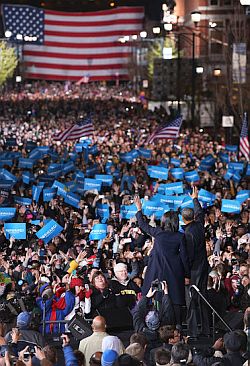
Michelle & Barack Obama wave to the crowd in Des Moines, Iowa, Nov. 5, 2012.
The President teared up a bit as he recalled those days, but went on to give a rousing 30-minute speech, telling the crowd, “I‘ve come back to Iowa one more time to ask for your vote,” adding that his campaign would “finish where we started.”
Beyond the nostalgia, Iowa was also a key state in the President’s Midwestern campaign strategy. Victories in Iowa, Wisconsin and Ohio would put the president over the required 270 electoral votes needed for reelection.
Obama was up by about five points in the state according to most of the Iowa polls, but his campaign was taking nothing for granted. The Des Moines Register had endorsed him in 2008, but this time the leading Iowa newspaper had sided with Mitt Romney. After the Iowa stop, the Obama campaign moved on to Chicago where, among other things, the President was scheduled to have a bit of exercise in a traditional election-day pick-up basketball game.
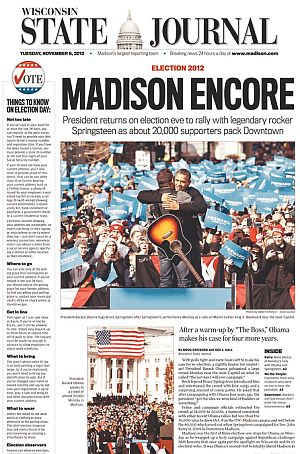
November 6, 2012: Election day edition of the “State Journal” newspaper in Madison, WI showing President Obama greeting Bruce Springsteen at rally a day earlier.
Election Day
On election day, voter turnout was heavy in a number of states, with polling places extending hours in some cases as long lines had formed. The ongoing tabulation of results remained close well into the night, with special attention focused on some seven key swing states, Ohio chief among them. Sometime after 11:15 pm Eastern Time, various news organizations called Ohio and Iowa for President Obama, and not long thereafter, at about 11:30 pm, they began calling the presidential election for Obama.
The final election results revealed that Obama took 50.96 percent of the popular vote with 65,464,068 votes, while Mitt Romney had 47.31 percent with 60,781,275 votes. The electoral talley was 332 for Obama and 206 for Romney.
In the various election post-mortems of how each candidate had performed, there were analysts who noted the help Obama had received from Hollywood and music industry celebrities. One post-election piece from Slate writer Ron Rosenbaum suggested that Bruce Springsteen’s appearances, in particular, might have played a key role in swaying undecided souls in key battleground states like Ohio:
…Indeed, in the final days, with Bruce riding around with Obama on Air Force One, it was almost as though he was on the ticket, Obama’s spiritual VP. Or at least ambassador from Asbury Park…. And the concerts and especially that song [“We Take Care of Our Own”] —the guy knows how to go straight for the heart, like a laser-guided drone. He knows how to make you feel, for at least an instant, we could all be better than we are. That’s a talent.
And with the election coming down to the last minutes, the last few votes, it can’t be insignificant that the demographic of attendees drawn to Obama campaign events by all those free Bruce concerts was the heart of the heart of the undecided voter segment that would eventually give Obama the election. After all, once you consider that Obama won Ohio by fewer than 2 percent, don’t try to tell me the combination of Sandy, Christie, and above all Bruce wasn’t the decider. In fact the Wall Street Journal post-election analysis of the Ohio vote put Obama’s margin in swing counties in Ohio at 16,176—about the total for a couple of small Bruce concerts…
Bruce Not Alone
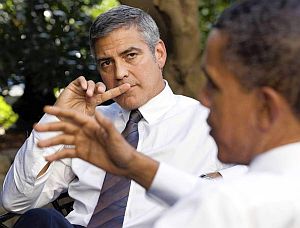
2010: President Obama talks with actor George Clooney outside Oval Office. Clooney hosted a Los Angeles fundraiser for the president in May 2012. Photo, Pete Souza/White House
In fact, throughout the 2012 campaign, a number of musicians helped Obama with concerts, rallies, and other support. In April, the Red Hot Chili Peppers gave a private performance for 1,200 campaign staffers in Cleveland; in July, Alicia Keys headlined a rally for women voters in Philadelphia; and in early October, Stevie Wonder, Katy Perry, Jon Bon Jovi and Jennifer Hudson all performed at a campaign event in Los Angeles. Dave Matthews performed at an Obama rally in Bristow, Virginia and also in Aurora, Colorado. In North Carolina, James Taylor undertook an eight-show tour on behalf of Obama, and Pearl Jam’s Eddie Vedder appeared at a $20,000-per-ticket fund-raiser in Tampa, Florida.
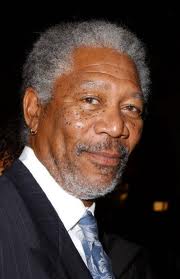
Actor Morgan Freeman was among five celebrity donors who each contributed one million dollars to support the Obama campaign.
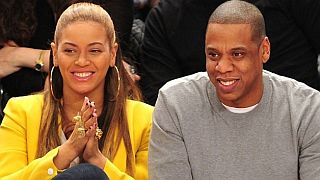
Music power couple Beyoncé & Jay-Z, shown here at a New Jersey Nets basketball game, hosted a special fundraiser for Obama in New York in Sept 2012.
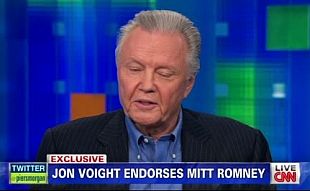
Actor Jon Voight – known for his roles in films such as “Midnight Cowboy” (1969), “Coming Home” (1978), and “Mission Impossible” (1996) – supported Mitt Romney.
But in terms of celebrity campaign donations, Romney had a relatively small share of the Hollywood/ music industry money pot, receiving some $46,500 from donors including: playwright Neil Simon, Olympic figure skater Kristi Yamaguchi, actor Orson Bean, producer Jerry Bruckheimer, professional football player Peyton Manning, and World Wrestling Entertainment CEO Vince McMahon and his wife, Linda, a Republican candidate herself, then running for the U.S. Senate seat in Connecticut being vacated by retiring Sen. Joe Lieberman. The McMahons were also among those donating to Restore Our Future, a conservative super PAC backing Romney’s bid. And the Republican National Committee picked up $78,886 from celebrity donors who included the McMahons, Jerry Bruckheimer, singer Pat Boone, New York Yankee baseball star, Alex Rodriguez, and others. But over the 2010-2012 election cycle, according to one count, Obama out-raised Romney by nearly a 5-to-1 margin among donors from the “TV/ movies/music” segment, receiving roughly $4.5 million in donations from that group compared to something under $1 million for the Romney campaign.
Springsteen Stood Out
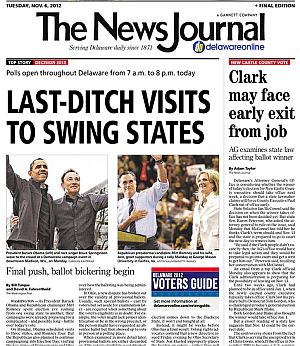
November 6, 2012 election-day edition of the Wilmington, Delaware “News Journal” newspaper, also ran the Obama-Springsteen photo on its front page.
But Springsteen has also shown himself to be one of the more thoughtful celebrities when he does become involved in political campaigning, not entering the fray lightly. In 2004, when he decided to take up the cause for John Kerry, he wrote an Op-Ed piece in the New York Times explaining his views on the candidate. And he has also used his website to post longer statements explaining his political views and the backing of particular candidates. But for most of his fans– Democrat, Republican, or Independent – his message is already transparent in his music, which normally conveys a determined, though sometimes angry but usually hopeful, American patriotism.
For other stories at this website with content related to Bruce Springsteen see, for example: “Steinbeck to Springsteen,” “Springsteen & Reagan,” and “Streets of Philadelphia.” Additional story choices on politics can be found at the “Politics & Society” category page. Thanks for visiting — and if you like what you find here, please make a donation to help support the research and writing at this website. Thank you. – Jack Doyle
|
Please Support Thank You |
____________________________________
Date Posted: 14 December 2012
Last Update: 27 October 2021
Comments to: jdoyle@pophistorydig.com
Article Citation:
Jack Doyle, “Barack & Bruce, 2008-2012,”
PopHistoryDig.com, December 14, 2012.
____________________________________
Sources, Links & Additional Information
Associated Press, “Springsteen Endorses Obama for President,”USA Today, April 16, 2008.
John Soeder, “Springsteen Plays New ‘Working on a Dream’ Tune at Obama Rally in Cleveland,” The Plain Dealer (Cleveland, Ohio), November 2, 2008.
Eliot Van Buskirk, “Recording Artists’ Eleventh-Hour Campaigns – Mostly for Obama,” Wired.com, November 3, 2008.
“Bruce Springsteen,” Wikipedia.org.
Jennifer Roche, “Inauguration Opening Celebration 2009 -‘We Are One’,” About .com.
Steve Hendrix and Jonathan Mummolo, “Jamming on the Mall for Obama,” Washington Post, January 18, 2009.
Office of the Press Secretary, The White House, “Remarks by the President at Reception for Kennedy Center Honorees,” East Room, The White House, December 6, 2009.
“Kennedy Center Honors: Obama On Bruce Springsteen, 2009,” YouTube.com.
David M. Halbfinger, “In New Jersey, Would-Be Boss Is Big Boss Fan,” New York Times, September 29, 2009.
David M. Halbfinger, “He Ain’t There on Business, Baby, He’s Only There for Fun,” New York Times, September 29, 2009.
Editorial, “Bruce Springsteen, Bring New Jersey Together and Play Gov.-elect Chris Christie’s Inauguration,” The Star-Ledger (Newark, NJ), Saturday, November 7, 2009.
David M. Halbfinger, “Christie’s 123rd Bruce Springsteen Concert Won’t Be at His Inauguration,” New York Times, December 9, 2009.
Stephen C. Webster, “Springsteen Drops Video for Obama 2012 Song: ‘We Take Care of Our Own’, RawStory.com, Friday, February 10, 2012.
Gloria Goodale, “As Election 2012 Nears, Hollywood Republicans Are Braving the Limelight,” CSMonitor.com, February 29, 2012.
Amy Bingham, “Celebrity Endorsers: Stars Align Behind Presidential Hopefuls,” ABC News, March 4, 2012.
Joyce Jones, “Jay-Z and Beyoncé to Host Obama Fundraiser; Tickets Cost $40,000 a Pop to Attend the New York City Event,” BET.com, September 12, 2012.
“Bruce Springsteen & Barack Obama: Boss Gets DNC Bump For ‘We Take Care Of Our Own’,” HuffingtonPost.com, September 13, 2012.
David Corn, “Secret Video: Romney Tells Millionaire Donors What He Really Thinks of Obama Voters,” MotherJones.com, Monday, September 17, 2012.
Matt Donnelly, “Obama Thanks Jay-Z, Praises Beyonce at Exclusive NYC Fundraiser,” Los Angeles Times, September 19, 2012.
Ben Yakas,”We Take Care Of Our Own: Bruce Springsteen To Campaign For Obama,” Gothamist.com, October 13, 2012.
“Bruce Springsteen To Campaign for Obama in Ohio,” NBCNews.com, October 13, 2012.
Brad Knickerbocker, “Bruce Springsteen Rocks Out for Barack Obama,” Christian Science Monitor, October 13, 2012
David Nakamura, “In Ohio, Bill Clinton and Bruce Springsteen Will Lend a Hand to Obama / After a Rocky Month, Campaign Looks To Tap an Infusion of Star Power,” Washington Post, Sunday October 14, 2012, p. A-11.
“Jay-Z Stumps for Obama in New Campaign Clip; President Embodies the ‘Hope of All the People Across the Country’,” Rolling Stone, October 15, 2012.
Steve Knopper, “Rockers Rally to Obama in Campaign’s Final Days; Why Bruce Springsteen, Jay-Z and Other Stars Are Stumping for the President,” Rolling Stone, October 17, 2012.
Bruce Springsteen, “A Message From Bruce,” BruceSpringsteen.net, October 17, 2012.
Helene Cooper, “Springsteen Helps Obama Lure Blue-Collar Votes in Ohio,” New York Times, October 18, 2012.
Associated Press, “Springsteen Explains Why He’s Supporting Obama,” Salon.com, Thursday, October 18, 2012.
Jim Rutenberg, The Caucus, “Springsteen Makes It Official: He’s for Obama,” New York Times, October 18, 2012.
Rosalind S. Helderman, “Bruce Springsteen, Bill Clinton Campaign for Obama at Ohio Rally,” Washington Post, October 18, 2012.
Chris Cillizza, “Bruce Springsteen, Barack Obama and the Fix Endorsement Hierarchy,” Washington Post, October 18, 2012.
Madeline Boardman, “Bruce Springsteen Imitates Obama And Improvises A Campaign Song At Virginia Rally,” HuffingtonPost .com, October 24, 2012.
William La Jeunesse, “Do Hollywood Endorsements Matter?,” FoxNews.com, October 25, 2012
“Bruce Springsteen Dedicates Song to Jersey Storm Victims at Penn State Gig; Rocker Sings ‘My City of Ruins’ for Asbury Park, Praises First Responders,” Rolling Stone, November 2, 2012.
Reuters & NBC Staff, “Stars Perform to Help Victims of Sandy,” NBCNews.com, Nov. 2, 2012.
James Sullivan, “Springsteen Leads Stars in Sandy Benefit,”Rolling Stone, November 3, 2012.
“NBC Hurricane Sandy Telethon Raises $23 Million; All-star Benefit Scores Big for Red Cross Disaster Relief,” Rolling Stone, November 5, 2012
“‘The Boss’ Joins the President in Wisconsin” Chicago Tribune (video), November 5, 2012.
Michael Leland, “The President and The Boss in Wisconsin,” Wisconsin Public Radio, November 5, 2012.
John Nichols, “Today Comes the Referendum: Will We ‘Take Care of Our Own’?” The Nation.com, November 5, 2012.
Rachel Weiner, “Springsteen and Obama Discussed Sandy on Flight,” Washington Post, November 5, 2012.
David Sarasohn, “Barack Obama’s Presidential Power — Mobilizing The Boss…” The Oregonian, November 6, 2012.
David Nakamura and Rachel Weiner, “The Boss Sings His Support,” Election 2012, Washington Post, November 6, 2012, p. A-4.
David Nakamura, “A Nostalgic Obama Returns to Iowa for The End of His Last Campaign,” Washington Post, November 6, 2012, p. A-7.
Associated Press, “Now ‘Friends,’ Christie & Springsteen Hug; NJ’s Governor Meets NJ’s Favorite Son as Both Pledge to Help Repair the Garden State,” NBC Philadelphia.com, Tuesday, November 6, 2012.
“Springsteen and Christie Are Total BFFs Now, Thanks to Sandy,” MSN.com, Nov. 6, 2012.
“Newspaper Front Pages Have One Message On Election Day,”HuffingtonPost.com, Nov. 6, 2012.
Ron Rosenbaum, “How Bruce Springsteen Elected Barack Obama,” Slate.com, Friday, November 9, 2012.
“Wrecking Ball” (Bruce Springsteen album), Wikipedia.org.
Bruce Springsteen (Op-Ed),”Chords for Change” New York Times, August 5, 2004.
“Newspaper Articles,” The Bruce Spring- steen Special Collection, Monmouth University, West Long Branch, New Jersey.
Cavan Sieczkowski, “Republican Hollywood: Celebrities Who May Vote For Mitt Romney In November Election,”HuffingtonPost .com, September 5, 2012.
“Bruce’s Speech From Madison, WI,” Bruce Springsteen.net, November 5, 2012.
Matt Orel, “Bruce Joins President Obama and Jay Z in Ohio,” BruceSpringsteen.net, November 5, 2012.
Tom Nettleton, “Bruce Joins President & Mrs. Obama in Iowa,” BruceSpringsteen.net, November 5, 2012.
Henry J. Gomez, “Obama Rallies with Springsteen and Jay-Z in Columbus, Calls out Republicans for ‘Cynicism’.” Plain Dealer (Cleveland, Ohio), November 5, 2012
Joe Hallett and Joe Vardon, “Candidates Give Celebrity-Studded Farewells to Columbus,” The Columbus Dispatch (Columbus, Ohio), Monday, November 5, 2012.
Deirdre Shesgreen, “Obama Columbus Rally: ‘Inspirational’,” Cincinnati.com, November 5, 2012.
Helene Cooper, “Campaign Diary: Candidates Spending Final Day in Swing States,” New York Times, November 5, 2012.
Brent Johnson, “Bruce Springsteen Joins Obama on Final Campaign Day,” The Star-Ledger, November 5, 2012.
Ali Weinberg, “Obama, Springsteen Wrap Up Wisconsin Campaign,” NBCNews.com, November 5, 2012.
Jim Kuhnhenn, Associated Press, “Obama Lines Up Stevie Wonder, Lady Gaga, Billie Jean King, Jay-Z & More In Campaign’s Final Days,” HuffingtonPost.com, November 5, 2012.
Zack O’Malley Greenburg, “Jay-Z, Barack Obama, Mitt Romney And The Politics Of Music,” Forbes.com, November 5, 2012.
“Bruce Springsteen For Obama: ‘Let’s Go To Work’ – In an Eloquent Speech, He Says the Election Decides the Difference Between the American Dream and American Reality,” Salon.com, Tuesday, November 6, 2012.
Helene Cooper, “A Bit of Quiet Optimism, and Some Superstition, Before a Tight Victory,” New York Times, November 6, 2012.
David Dolmage, “President and Michelle Obama, Bruce Springsteen Rally Iowa Voters One Last Time” (photos), West Des Moines Patch, November 6, 2012.
Associated Press, “AP Calls the Presidential Race – State by State,” AP.org, November 7, 2012.
Adam Nagourney and Jim Rutenberg, “Obama’s New Courting of Hollywood Pays Off,” New York Times, May 9, 2012.
Mackenzie Weinger, “Hollywood Stars Open Wallets for Obama,” Politico.com, July 12, 2011.
Anna M. Tinsley, “Stars Shine Again in 2012 Campaigns,” Star-Telegram.com (Ft. Worth, Texas), Monday, October 1, 2012.
Michael Janofsky, Reuters, “Hollywood Votes with its Wallet: Obama Holds 16-1 Advantage in Fund-Raising,” Chicago Tribune.com, October 27, 2012.
“List of Barack Obama Presidential Campaign Endorsements, 2012” (entertainment group), Wikipedia.org.
“Contributions from Celebrities – 2012 Presidential,” OpenSecrets.org, accessed, December 8, 2012.
________________________________
